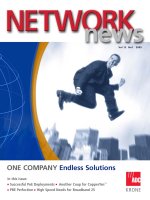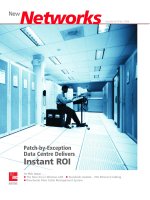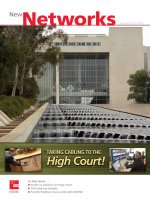ADC KRONE Network News - Vol.12 No.3 - 2005
Bạn đang xem bản rút gọn của tài liệu. Xem và tải ngay bản đầy đủ của tài liệu tại đây (1.22 MB, 16 trang )
In this issue . . .
■
What’s the fuss about “Cat 7”?
■
ADC KRONE Joins FTTH Council
■
Central Coast Manufacturer of the Year 2005!
Network News 12_3.qxp-Layout 1 9/08/2005 12:02 PM Page 1
N
o one knows communications network
infrastructure like ADC KRONE. Sharing our
knowledge is a promise we make to you day in
and day out, to enable you to make the best
infrastructure decisions possible.
Being an inaugural member of the Fibre-To-
The-Home Council in Asia Pacific is yet another
example of this promise. Our membership in the
FTTH Council will allow us to share with you the
latest technology trends and application
requirements, guidelines for educated business
decisions and best practices for implementation
from all over the world. Dave Anderson explains
this further on page three, it’s worth a read.
Earlier this year we introduced the Australian
market to the new TrueNet
®
- the one true
network infrastructure solution. It features the
combined ADC KRONE portfolio of products for
enterprise customers. We have had considerable
interest in our portfolio additions. In fact, there
have already been significant sales of products,
particularly in TrueNet’s enhanced fibre offerings.
This shows how the benefits of the ADC KRONE
integration are delivered to you - our customer.
Glen Johnston introduces the FibreGuide range
on page twelve, a good way for you to find out
more about our new fibre offerings.
For more than 20 years ADC KRONE has
maintained a leading position in the Australian
IT&T market, demonstrating consistent excellence
in manufacturing processes and product
innovation. The numerous awards from AEEMA
and CCMA are a clear signal of our dedication to
excellence and innovation. We are pleased to
announce that in line with this proud history, for
the second consecutive year, we have won the
title of Central Coast Manufacturer of the Year.
Please join me in congratulating our Australian
staff on this achievement.
ADC KRONE succeeds because of our people
and customers. I would like to thank all of our
valued customers who continue to vote with their
orders for ADC KRONE and who enable us to
succeed where other brands have failed to grow
their market share.
Sincerely,
Bob Fitzgerald
VP Regional Director
Asia Pacific
2
❙
NETWORKnews
A NOTE FROM BOB FITZGERALD
ADC KRONE News
3 Stake In The Ground For FTTH
14 Outstanding Success At CeBIT
15 ADC KRONE Scores Three Wins
at the Central Coast
Manufacturing Awards
Technical Articles
4 What’s The Fuss About “Cat 7”
10 Planning For 10Gbps Ethernet
12 Fibreguide Fibre Management
System
Customer Stories
6 Banking On Copper
Editor: Sarah Bishop
Art Direction: Nora Collins
Website: adckrone.com/au
CONTENTS
Copyright © 2005 ADC Communications (Australia) Pty Limited.
Network News 12_3.qxp-Layout 1 9/08/2005 12:02 PM Page 2
W
ithin Australia, FTTH is a “rising sun”
technology that will ultimately replace the
current copper-based and HFC-based telephone
and cable TV networks and is currently the
subject of trials. The latest of these trials is in
Tasmania where 1,000 premises will be linked via
a FTTH network.
ADC KRONE aims to be a significant leader in
the Australian market, providing world class fibre
infrastructure. Being a global operation, ADC
KRONE is able to utilise our global scale and
locally implement best practice in technology
deployments from other markets, particularly the
United States.
ADC KRONE is engaged in negotiations with
carriers and technology providers to assist in
overcoming the new infrastructure challenges
that FTTH deployments bring, specifically with our
harsh environment and conditions.
Surveys of FTTH activity around the world show
that there are well over a million subscribers
already connected on optical fibre access, the
Asia Pacific region is the fastest growing market
and has the highest number of subscribers.
According to Dittberner Associates, Inc., the
worldwide capital expenditures related to FTTH
access technology will reach US$22.8 billion in
2013, from an estimated US$3.7 billion in 2004
and predicts that the Asia Pacific region will be
the largest market for FTTH access technology
with 52.8% of the total, or US$12 billion dollars.
The FTTH council is a non-profit organisation
whose mission is to educate, promote and
accelerate FTTH and the resulting economic and
quality of life enhancements across the Asia
Pacific region.
The inaugural Asia Pacific general meeting was
held in Yokohama Japan from 31 May - 1 June
2005 and was attended by YK Loke from our
Singapore office. Also in attendance and
presenting for ADC KRONE was Patrick Sims, who
is the Chairman of the North American FTTH
Council.
Our second participant in the forum is Alan
Crawford who is based at Asia Pacific headquarters
in Australia. Alan has a very strong background in
fibre and will be furthering our participation by
attending an upcoming meeting in Taiwan to
ensure we bring to Australia the global
knowledge in this exciting new field.
Please contact your local ADC KRONE office for
assistance in your deployments or if you would
like to be kept up to date with proceedings in the
forum.
■
NETWORKnews
❙
3
STAKE IN THE GROUND FOR FTTH
ADC KRONE is proud to announce that we are a founding member of
the Asia Pacific division of the Fibre To The Home (FTTH) Council.
Dave Anderson, Regional
Director Sales and Sales
Support, Carrier Networks,
Indo Pacific
The FTTH council is a
non-profit organisation
whose mission is to educate,
promote and accelerate FTTH
and the resulting economic
and quality of life
enhancements across the Asia
Pacific region.
Network News 12_3.qxp-Layout 1 9/08/2005 12:02 PM Page 3
I
f you want to strike fear into the heart of your
local cabling installer you need go no further
than mentioning Cat 7. If you want to strike fear
into the heart of your CFO you need go no further
than mentioning a cabling infrastructure at triple
the cost. There is a great amount of
misinformation in the marketplace about Cat 7.
This article answers some exaggerated claims and
seeks to bring facts into the discussion.
The past often helps to predict the future.
Knowing that Ethernet has evolved in speed by a
factor of 10 we can safely assume that the next
leap would move the industry to 10Gbps over
UTP. This already became a reality with fibre,
accepted in 2002 as a backbone technology. In
the design and implementation of networks we
are taught to ensure backbone speeds are 10
times greater than that of our typical
telecommunications outlet (TO). Today 4 pair
Gigabit Ethernet (1000BaseT) is the default
standard transceiver, outselling 10/100Mbps
solutions in NIC and switch port sales.
This brings us to the question of which copper
cabling solution will support 10Gig to 100m. Cat 6
was meant to offer some level of future proofing
for such an event. Unfortunately it did not! The
IEEE 802.3an 10GBaseT Working Group in 2003
identified deficiencies within Cat 6 that prohibited
its use for 10Gig to the full 100m. In doing so, this
opened up Pandora’s box to supporters of Cat 7
Class F.
So what is this magical cabling solution in Cat 7
that can support 10Gbps? It’s not only shielded
but the shield is triple-screened! It looks
conspicuously similar to the IBM Type 6 cable of
yesteryear. Hold on...does this mean the
supporters of shielded solutions got it right?
Not exactly! Remember that four letter word –
cost. This was the primary driver within the IEEE
802.3an 10GBaseT Working Group (now a Task
Force) that drove them to identify why Cat 6
would not work for the full 100m and target
specifications for the cabling industry to develop
a new UTP solution that would work
i.e. Augmented Cat 6.
The IEEE 802.3an 10GBaseT Task Force is made
up primarily of active hardware members. These
are the makers of chipsets, protocols and the
boxes that house them. It’s worth noting that
these members are not there for the equitable
distribution of technology, but rather as
representatives of their companies, interested in
selling technology. This drove the development of
the new form of Cat 6 – Augmented Cat 6.
Simply speaking, take advantage of the good
characteristics within Cat 6 and augment/change
the parameters that are deemed to need
improvement.
Fortunately, the cabling industry met the
challenge in developing an Augmented Cat 6
solution that can be used for the full 100m
4
❙
NETWORKnews
WHAT’S THE FUSS ABOUT “CAT 7”?
Tim Takala discusses the timing of Cat 7 – with 10 Gig looming is it
ripe or hype?
Tim Takala,
Corporate Business
Manager
So where do you think
this leaves the
supporters/suppliers of
Cat 7? They’ve actually come
up with some pretty creative
marketing.
Network News 12_3.qxp-Layout 1 9/08/2005 12:02 PM Page 4
deployment of 10Gbps. Barriers of Alien Crosstalk
and Insertion Loss were met through clever
engineering and innovation to allow UTP cable to
yet again offer a cost effective means of
transporting high speed data.
With the above in mind do you think
companies that sell switches would like to tell
their customers that they can run 10Gig using
their new hot off the press “U beaut” 10Gig
Switch, BUT they must install Cat 7, at triple the
cost? Or that the customer’s current Cat 6
solution can be used for 55m and Augmented
Cat 6 can be installed to run the full 100m at
lower cost, typically only a 30% increase over
current Cat 6? It is a barrier to market for switch
manufacturers if the customer is required to
upgrade their existing cabling to support the
implementation new technology.
So where do you think this leaves the
supporters / suppliers of Cat 7? They’ve actually
come up with some pretty creative marketing.
For one, they are saying that Augmented Cat 6
requires additional skills beyond Cat 6. This is
simply not true. Augmented Cat 6 is Cat 6, only
engineering to mitigate the effects of alien
crosstalk. As long as the manufacturer’s
instructions are followed, the time and skill to
install the solution are the same.
They are also saying that the size of the cable is
“about 8mm OD”. This is also not true. ADC
KRONE’s version of this cable has a 6.7mm
nominal OD. This is still well below that of Cat 7.
Another argument in support of Cat 7 states
“you can split the pairs to save money”. I found this
particularly entertaining considering that Gigabit
Ethernet, much less 10Gig, requires all 4 pairs to
work! If this were done you would be left with a
network that supported 100BaseTX Ethernet at a
maximum. You might as well be installing old Cat 5
UTP. One supporter of Cat 7 was even bold enough
to suggest that you can install a single Cat 7 cable
instead of 3 Cat 5e cables to the same location. The
only logic in doing this would be that a single Cat 7
cable would cost you as much or more than 3 Cat
5e cables!
Cat 7 cabling solutions do have a place in the
market. Otherwise customers would not be
buying them. They offer excellent protection from
EMI and some enhanced security over UTP
solutions. That being said, the existing market
share says it all. Gone are the days of endless IT
funding. CFO’s are asking hard questions
regarding where funding is spent and rightfully
so. In order to make 10Gig infrastructures a viable
reality, a cost effective solution needs to be
deployed with the longest timeline to
obsolescence, as well as a justifiable return on
investment.
Augmented Cat 6 offers the ability to deliver
10Gig, to the full 100m distance of its Cat 5e and
Cat 6 predecessors, while at the same time
offering that next tenfold leap in Ethernet that its
Cat 6 predecessor could not. This is all done on an
Unshielded Twisted Pair solution that installers are
already eagerly embracing, and customers are
buying!
■
NETWORKnews
❙
5
?
“Cat 7 supporters are saying that
Augmented Cat 6 requires additional
skills beyond Cat 6. This is simply not
true. As long as the manufacturer’s
instructions are followed, the time and
skill to install the solution are the same.”
Clockwise from the
left: coaxial cable,
STP Cat 7 and UTP
Cat 6 cable.
Network News 12_3.qxp-Layout 1 9/08/2005 12:02 PM Page 5
W
hen Phil Rogerson, network manager
Europe, for ‘The Bank’ was tasked with
building a new European data centre for his
company he knew he had a tough time ahead.
Michael Crane talked to Phil and to Steve Banks,
an independent consultant retained by the Bank,
to help with the project.
The Bank - one of the major multinationals
which for security reasons we’re not
permitted to name - has a massive
presence in London with thousands
of staff, hundreds of high-
powered “traders” and all of the
services to support them.
The Bank’s European
operations are equally massive
and progress (since this scribe
reported on the building
of the previous comms
room/data centre some
seven years ago) has moved on to
such a degree that a completely new
London-based data centre was needed to support
not just UK but pan-European operations.
THE REQUIREMENTS
Responsible for the design, implementation and
management of the Bank’s physical infrastructure
throughout Europe, Phil Rogerson is acutely
aware of his organisation’s dependence on the
infrastructure he lays down - and the risk to the
business of failures in that infrastructure.
Rogerson explained, “The Bank’s traders trade
multi millions each day and almost all of our
business is either conducted electronically or relies
on IT systems. The cost to the company of
downtime is stratospheric - probably millions of
dollars per minute. They expect system availability
of at least 61 minutes in every hour and when they
want a move or change done the expectation is
yesterday, not sometime today or tomorrow!”
Of course in today’s banking business, IT is an
area they all invest in extensively because
providing information to their bank’s traders 10 or
20 milliseconds faster than their competitors gives
them the edge in that manic high-stress trader-
floor environment that we’ve all seen on the TV.
“This banking culture,” explained Rogerson,
“puts two opposing requirements on us for the
physical network. On the one hand is the need to
future proof. You only get one chance to set up a
data centre for its five to seven year life. There’s
no question of going in halfway through because
you didn’t put in fast enough cabling
infrastructure when you built it, so future
proofing is a very high priority”.
“But on the other hand, the IT infrastructure
has to be absolutely rock solid because downtime
BANKING ON COPPER
A NEW SPIN ON INVESTING FOR THE FUTURE...BY A BA
‘The Bank’ – a major multinational which for security reasons we’re
not permitted to name – has just completed a 10Gig copper network
infrastructure upgrade.
Network News 12_3.qxp-Layout 1 9/08/2005 12:03 PM Page 6









